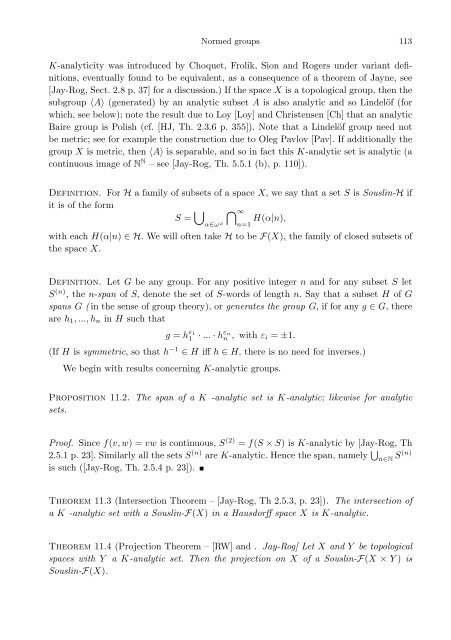Normed versus topological groups: Dichotomy and duality
Normed versus topological groups: Dichotomy and duality
Normed versus topological groups: Dichotomy and duality
You also want an ePaper? Increase the reach of your titles
YUMPU automatically turns print PDFs into web optimized ePapers that Google loves.
<strong>Normed</strong> <strong>groups</strong> 113K-analyticity was introduced by Choquet, Frolik, Sion <strong>and</strong> Rogers under variant definitions,eventually found to be equivalent, as a consequence of a theorem of Jayne, see[Jay-Rog, Sect. 2.8 p. 37] for a discussion.) If the space X is a <strong>topological</strong> group, then thesubgroup 〈A〉 (generated) by an analytic subset A is also analytic <strong>and</strong> so Lindelöf (forwhich, see below); note the result due to Loy [Loy] <strong>and</strong> Christensen [Ch] that an analyticBaire group is Polish (cf. [HJ, Th. 2.3.6 p. 355]). Note that a Lindelöf group need notbe metric; see for example the construction due to Oleg Pavlov [Pav]. If additionally thegroup X is metric, then 〈A〉 is separable, <strong>and</strong> so in fact this K-analytic set is analytic (acontinuous image of N N – see [Jay-Rog, Th. 5.5.1 (b), p. 110]).Definition. For H a family of subsets of a space X, we say that a set S is Souslin-H ifit is of the formS = ⋃ α∈ω ω ⋂ ∞n=1 H(α|n),with each H(α|n) ∈ H. We will often take H to be F(X), the family of closed subsets ofthe space X.Definition. Let G be any group. For any positive integer n <strong>and</strong> for any subset S letS (n) , the n-span of S, denote the set of S-words of length n. Say that a subset H of Gspans G ( in the sense of group theory), or generates the group G, if for any g ∈ G, thereare h 1 , ..., h n in H such thatg = h ε 11 · ... · hε nn , with ε i = ±1.(If H is symmetric, so that h −1 ∈ H iff h ∈ H, there is no need for inverses.)We begin with results concerning K-analytic <strong>groups</strong>.Proposition 11.2. The span of a K -analytic set is K-analytic; likewise for analyticsets.Proof. Since f(v, w) = vw is continuous, S (2) = f(S × S) is K-analytic by [Jay-Rog, Th2.5.1 p. 23]. Similarly all the sets S (n) are K-analytic. Hence the span, namely ⋃ n∈N S(n)is such ([Jay-Rog, Th. 2.5.4 p. 23]).Theorem 11.3 (Intersection Theorem – [Jay-Rog, Th 2.5.3, p. 23]). The intersection ofa K -analytic set with a Souslin-F(X) in a Hausdorff space X is K-analytic.Theorem 11.4 (Projection Theorem – [RW] <strong>and</strong> . Jay-Rog] Let X <strong>and</strong> Y be <strong>topological</strong>spaces with Y a K-analytic set. Then the projection on X of a Souslin-F(X × Y ) isSouslin-F(X).
















